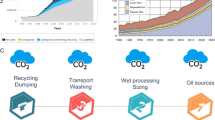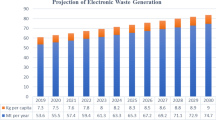Abstract
Purpose
The environmental burdens of the same dish (a traditional hot stew with pulses and pieces of pork sausages and ham) cooked at four different production scales was analyzed by life cycle assessment (LCA): (a) canned, industrially manufactured and consumed at home; (b) catering company, serving the product for schools; (c) restaurant, cooked in a traditional way and served; and (d) homemade, cooked, and consumed at household level.
Methods
The LCA methodology was applied following the ISO 14044:2006 guidelines. For the inventory analysis, industrial data were obtained from a ready meals factory. Other primary data were directly obtained from the systems analyzed (catering, restaurant and homemade levels). Databases (Ecoinvent, LCA Food DK, BUWAL250, IDEMAT 2001, ETH-ESU 96) were used together with the SimaPro v7.3.3. For the impact assessment, the Eco-indicator 99 method and the CML 2 baseline method were used. In cases (c) and (d), different scenarios for the origin of raw materials and source of energy for cooking were considered. In level (a), an additional scenario considering a 50% reduction of food wastes was also investigated.
Results and discussion
The main contribution was meat ingredients, followed by energy consumption. Despite the higher environmental loads in transportation, the factory showed an environmental performance similar to cooking at home with gas. These results can be explained by the implementation of heat recovery systems at industrial scale. The restaurant showed the worst environmental performance. The main reason was that all the energy consumed in the restaurant (even not directly related to cooking) was attributed to the exclusive purpose of serving the food, since no other activities were carried out in the business. Consumer’s choices such as the preference for eating in a restaurant or the energy used for cooking turned out to be important differentiating factors.
Conclusions and recommendations
LCA allowed critical aspects to be identified in order to improve sustainable food production and consumption patterns. Electricity consumption and the amount of wastes sent to landfill turned out to be critical control points. In the case of complex dishes such as stews, the higher scale systems in the study (the factory and catering company), with proper energy and environmental practices, can have lower environmental burdens than small-scale systems, such as homemade cooking using a ceramic-glass cooktop or consumption in traditional restaurants. To reinforce the role of education, specific programs on the need to save food and the environmental impact of dietary choices must be implemented at schools.





Similar content being viewed by others
References
Andersson K, Ohlsson T, Olsson P (1994) Life cycle assessment (LCA) of food products and production systems. Trends Food Sci Tech 5:134–138
Bare JC, Norris GA, Pennington DW, McKone T (2003) TRACI—the tool for the reduction and assessment of chemical and other environmental impacts. J Ind Ecol 6:49–78
Baumann H, Tillman AM (2004) The Hitch Hiker’s guide to LCA: an orientation in life cycle assessment methodology and application. Studentlitteratur, Lund
Biswas WK, Naude G (2016) A life cycle assessment of processed meat products supplied to Barrow Island: a Western Australian case study. J Food Eng 180:48–59
Caduff M, Huijbregts MAJ, Althaus H-J, Koehler A, Hellweg S (2012) Wind power electricity: the bigger the turbine, the greener the electricity? Environ Science Technol 46:4725–4733
Calderón LA, Iglesias L, Laca A, Herrero M, Díaz M (2010) The utility of life cycle assessment in the ready meal food industry. Resour Conserv Recy 54:1196–1207
Davis J, Sonesson U (2008) Life cycle assessment of integrated food chains—a Swedish case study of two chicken meals. Int J Life Cycle Assess 13:574–584
De Isabel, J.A., García, M., Egido C. (2012) Guide for energy audits in restaurants of the community of Madrid. Energy foundation of the community of Madrid. http://www.fenercom.com
De Menna F, Vittuari M, Molari G (2015) Impact evaluation of integrated food-bioenergy systems: a comparative LCA of peach nectar. Biomass Bioenergy 73:48–61
Defra. Food Industry Sustainability Strategy (FISS) (2006) Published by the Department for Environmental, Food and Rural Affairs. Defra, London http://www.defra.gov.uk
Ecoembes (2007) Annual Report. http://www.ecoembes.com
Edwards-Jones G, Milà i Canals L, Hounsome N, Truningerd M, Koerber G, Hounsome B, Cross P, York EH, Hospido A, Plassmann K, Harris IM, Edwards RT, Day GAS, Tomos AD, Cowell SJ, Jones DL (2008) Testing the assertion that “local food” is the best: the challenge of an evidence-based approach. Trends Food Sci Tech 19:265–274
EIA - U.S. Energy Information Administration (2003) http://www.eia.gov
Ganesh VR (2013) Life cycle analysis of the processed food versus the whole food (potato). Int J Appl Sci Eng Res 2(1):70–78
Hällstrom E, Carlsson-Kanyama A, Börjesson P (2015) Environmental impact of dietary change: a systematic review. J Clean Prod 91:1–11
Hauschild MZ, Goedkoop M, Guinée J, Heijungs R, Huijbregts M, Jolliet O, Margni M, De Schryver A, Humbert S, Laurent A, Sala S, Pant R (2013) Identifying best existing practice for characterization modeling in life cycle impact assessment. Int J Life Cycle Assess 18:683–697
Heller MC, Keoleian GA (2003) Assessing the sustainability of the US food system: a life cycle perspective. Agric Syst 76:1007–1041
Iglesias L, Laca A, Herrero M, Díaz M (2012) A life cycle assessment comparison between centralized and decentralized biodiesel production from raw sunflower oil and waste cooking oils. J Clean Prod 37:162–171
Jungbluth N, Büsser S, Frischknecht R, Flury K, Stucki M (2012) Feasibility of environmental product information based on life cycle thinking and recommendations for Switzerland. J Clean Prod 28:187–197
Katajajuuri J-M, Silvennoinen K, Hartikainen H, Heikkilä L, Reinikainen A (2014) Food waste in the Finnish food chain. J Clean Prod 73:322–329
Lloyd SM, Ries R (2007) Characterizing, propagating and analyzing uncertainty in life-cycle assessment. A survey of quantitative approaches. A survey of quantitative approaches. J Ind Ecol 11:161–179
Lundqvist J, de Fraiture C, Molden D (2008) Saving water: from field to fork—curbing losses and wastage in the food chain. In SIWI Policy Brief, Stockholm
Notarnicola B, Tassielli G, Renzulli PA, Castellani V, Sala S (2017) Environmental impacts of food consumption in Europe. J Clean Prod 140:753–765
Parfitt J, Barthel M, Macnaughton S (2010) Food waste within food supply chains: quantification and potential for change to 2050. Phil Trans R Soc B 365:3065–3081
Reynolds CJ, Piantadosi J, Buckley JD, Weinstein P, Boland J (2015) Evaluation of the environmental impact of weekly food consumption in different socio-economic households in Australia using environmentally extended input-output analysis. Ecol Econ 111:58–64
Roy P, Nei D, Orikasa T, Xu Q, Okadome H, Nakamura N, Shiina T (2009) A review of life cycle assessment (LCA) on some food products. J Food Eng 90:1–10
Saarinen M, Kurppa S, Virtanen Y, Usva K, Mäkelä J, Nissinen A (2012) Life cycle assessment approach to the impact of home-made, ready-to-eat and school lunches on climate and eutrophication. J Clean Prod 28:177–186
Schmidt Rivera XC, Espinoza Orias N, Azapagic A (2014) Life cycle environmental impacts of convenience food: comparison of ready and home-made meals. J Clean Prod 73:294–309
Sonesson U, Mattsson B, Nybrant T, Ohlsson T (2005) Industrial processing versus home cooking: an environmental comparison between three ways to prepare a meal. Royal Swedish Academy of Sciences Ambio 34:414–421
Steinfeld H, Gerber P, Wassenaar T, Castel V, Rosales M, de Haan C (2006) Livestock’s long shadow—environmental issues and options. FAO – Food and Agriculture Organization of the United Nations, Rome
Tilman D, Clark M (2014) Global diets link environmental sustainability and human health. Nature 515:518–522
Tucker G, Foster C, Wiltshire J (2010) Life cycle analysis and carbon footprinting with respect to sustainability in the agri-food sector. IUFoST SIB
Tukker A, Jansen B (2006) Environment impacts of products—a detailed review of studies. J Ind Ecol 10:159–182
Tukker A, Huppes G, Guinée JB, Heijungs R, Koning A, Oers LFCM, Suh S, Geerken T, Holderbeke M, Jansen B, Nielsen P (2006) Environmental impacts of products (EIPRO). Analysis of the life cycle environmental impacts related to the final consumption of the EU-25. European Commission, JRC e IPTS, Luxembourg
Ventour L (2008) The food we waste. In: Waste & resources action programme (WRAP); ISBN 1–84405–383-0
Weber CL, Matthews HS (2008) Food-miles and the relative climate impacts of food choices in the United States. Environ Sci Technol 42:3508–3513
Wilfart A, Prudhomme J, Blancheton JP, Aubin J (2013) LCA and emergy accounting of aquaculture systems: towards ecological intensification. J Environ Manag 121:96–109
Williams AG, Audsley E, Sandars DL (2006) Final report to Defra on project IS0205: determining the environmental burdens and resource use in the production of agricultural and horticultural commodities: a report to the Department for Environmental, Food and Rural Affairs. Defra, London
Zufia J, Arana L (2008) Life cycle assessment to eco-design food products: industrial cooked dish case study. J Clean Prod 16:1915–1921
Author information
Authors and Affiliations
Corresponding author
Additional information
Responsible editor: Niels Jungbluth
Rights and permissions
About this article
Cite this article
Calderón, L.A., Herrero, M., Laca, A. et al. Environmental impact of a traditional cooked dish at four different manufacturing scales: from ready meal industry and catering company to traditional restaurant and homemade. Int J Life Cycle Assess 23, 811–823 (2018). https://doi.org/10.1007/s11367-017-1326-7
Received:
Accepted:
Published:
Issue Date:
DOI: https://doi.org/10.1007/s11367-017-1326-7




